Condiment paprika research in Australia
Abstract
Australian condiment paprika plant improvement research is 10 years old. The production and processing industry is in its infancy. The research is producing condiment paprika cultivars suitable for a highly mechanised crop husbandry system, with genes for early lignification of the stem, fruits for detachability of the calyx, high dry matter and pigment content. A potential hybrid seed production system is discussed.
Introduction
Capsicum is one of the most versatile crops in cultivation. The fruit range from tiny very hot chillies and stocky pimentos through to long cayenne chillies and the giant ‘Bell capsicums’. Both pungent and non-pungent variants are used as foods, spices, medicines and a source of pigments. In some countries capsicum is a national food used in many ways; raw, smoked, cooked, stuffed and as a salad and spice [1]. The condiment form is a highly valued spice and the extract of the spice, oleoresin, is used in the smallgoods and canning industries. More recently the cosmetic industry is making use of it as a source of natural pigment.
Several capsicum types are grown throughout Australia. Commercial production is on a market garden scale and is restricted to table capsicums for salads and cooking. Chillies and condiment paprika are mainly grown in domestic gardens by families of European and South American origin. Australia imports approximately $5 million worth of paprika products per year and these include milled paprika, flakes and dried unmilled paprika [2]. Recently some oleoresin was also imported for the food and cosmetic industries.
Although Australia has a 10 year-old research program in condiment paprika; commercial production is only just starting. The problem has been the relatively large amount of capital required to establish economically sound production. Without mechanised planting, harvesting and drying systems, the industry will not survive in Australia.
Hungary has produced very high quality condiment paprika (Capsicum annuum v. annuum Longum Group) unparalleled on the world market: its bouquet, taste and colour are supreme. Nevertheless, Hungarian paprika exports have declined significantly during the past years. This was partly due to heavy metal contamination caused by air pollution originating from the use of leaded petrol. Some unscrupulous companies were selling adulterated paprika that created bad publicity for the industry. The Hungarian authorities had to destroy approximately 25,000 tons of adulterated paprika and the paprika export industry declined significantly as a result. Exports to their traditional customers such as Czech Republic, Japan and Germany had nearly stopped ten years ago [2]. More recently, both local sales and exports of whole paprika and paprika products had to be stopped due to aflatoxin contamination. This was caused by dilution of the Hungarian product with paprika imported from South America [3,4].
In 1994, the senior author received a private communication from a Hungarian wheat breeder colleague advising him of the problems that the Hungarian condiment paprika industry was facing. The senior author’s response to his old colleague was that the problem, mainly referring to air pollution, could be easily solved by producing the famous Hungarian condiment paprika in Australia, in cooperation with the Hungarian researchers. Subsequently Dr. Norbert Somogyi,1 at the time a research scientist with the Hungarian Vegetable Crop Research Institute Condiment Paprika Research Unit in Szeged, contacted the senior author for further discussions. He and his superiors liked the idea of producing the Hungarian condiment paprika in Australia. On 28th March 1996, a close collaboration was established between The Hungarian Vegetable Crop Research Institute, the Condiment Paprika Unit and the family company of the senior author, ASAS Pty Ltd. This authorised ASAS Pty Ltd to be the sole representative of the Paprika Unit in Australia and in the South Pacific region.
The Hungarians provided us with their most popular cultivars. These cultivars were included in a small-scale field trial at The University of Sydney, Plant Breeding Institute Cobbitty, NSW. This trial, our earlier experiments and the practical experience of many market gardeners demonstrated that Capsicum cultivars of Hungarian origin can be successfully produced on the Australian continent. However it became clear that condiment paprika could not be produced economically with the same crop husbandry methods as in Hungary and other condiment paprika producing countries where manual labour is comparatively inexpensive. The imported cultivars also expressed quite a degree of variability due to genotype-environment interactions. For these reasons, it was decided to initiate a research program to find the most suitable crop husbandry systems and develop cultivars that were suitable for highly mechanised production techniques. To achieve these objectives a request was lodged to the Australian Government Rural Industries Research & Development Corporation (RIRDC) for research funding to assist the project.
Subsequently, research co-operation was established with The University of Sydney Plant Breeding Institute, ASAS Pty Ltd, The Hungarian Paprika Unit, Szeged, and the Rural Industries Research & Development Corporation.
I. The groundwork
ASAS Pty Limited was the applicant and later the grantee for the research project under the title “Condiment Paprika Breeding, Harvesting and Commercialisation”. The aim of this project was to introduce and further develop genetic material of condiment paprika to produce cultivars with high initial pigment (>200 ASTA) and dry matter content (>18%) suitable for direct seeding and mechanical harvesting. Later aims were to develop a commercially viable integrated production, harvesting and processing system for identified markets.
Initial pilot tests strongly indicated that under Australian environmental conditions, Hungarian cultivars generate considerably higher pigment content in their fruits than in their country of origin. Whereas most of the Hungarian milled paprika on the world market is around 120-130 ASTA (American Spice Trade Association method 20.1) the same cultivars grown in Australia were producing on a semi commercial scale 180-250 ASTA in milled product. Table 1 shows some comparisons.
The first two samples were received by the senior author while visiting Hungary. The above figures clearly show large differences. The question may be asked why there are such big differences between the imported and the Australian grown milled product. The answer was simple in the case of samples collected from supermarkets in Australia. Importers were buying the cheapest available product.
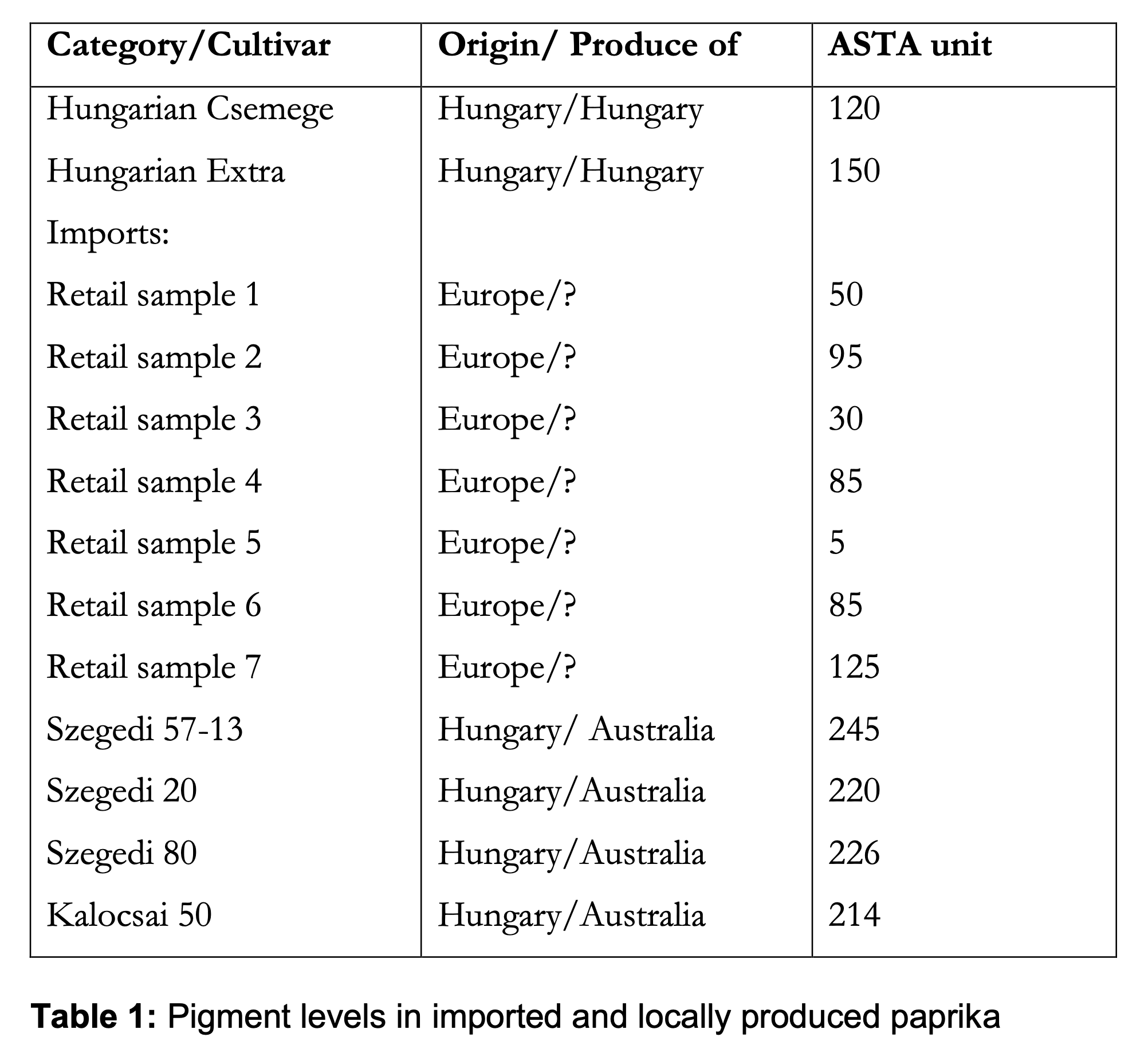
The retail sample “5” may have been botanically derived from Capsicum, but was in fact a residue of milled product from which the oleoresin had been extracted! The quality of this imported product was inferior. Australians are not generally known to be paprika connoisseurs; only those immigrants familiar with better grades of milled paprika would know the difference and would wish to purchase a high quality product.
examined the crop husbandry methods used in both countries to ascertain whether Hungarian agronomic conditions may be more advantageous for paprika production. There is one obvious major difference between the environments of the two countries: namely the number of sunshine hours and sunshine intensity to which the crop is exposed during cultivation. Table 2 demonstrates the differences. Major paprika producing or potential producing regions are shown.
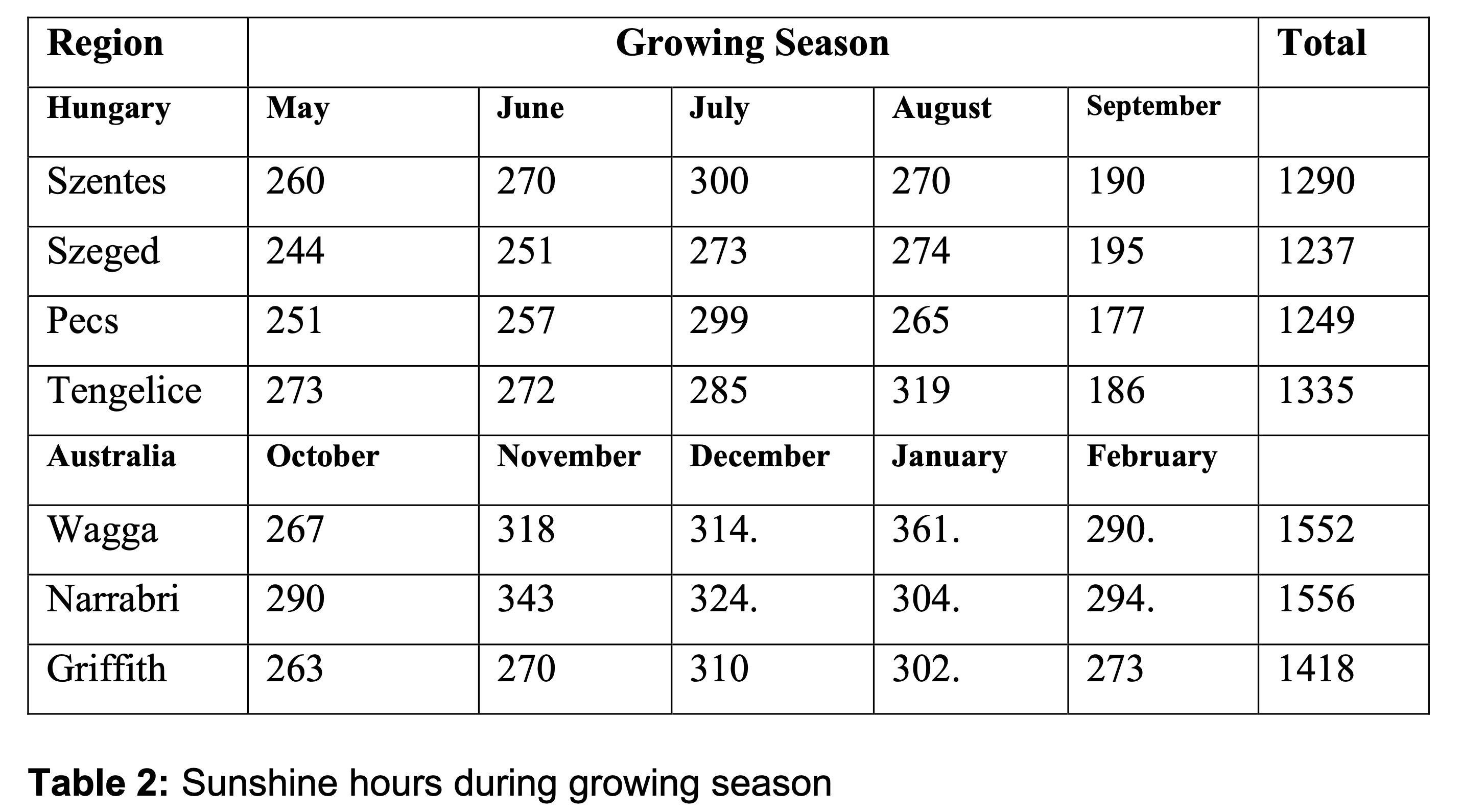
The mean temperature in Hungary at Szentes and Szeged during the May-September growing season is 18.9oC and 19.6oC, respectively [5]; in Australia at Narrabri and Wagga the corresponding means are 23.1oC and 21oC (Aust. Bureau of Meteorology).
One of the most important goals was to find genotypes that could provide a base to create cultivars suitable for a mechanised farming system. Most capsicum genotypes have an indeterminate growth habit, with the plants flowering and bearing fruit continuously. Therefore, several harvests are needed to obtain a full yield. It is essential to find genotypes that allow a large part of the potential yield to be harvested in one operation. An obvious option was to look for variants with a determinate growth habit. A number of Hungarian cultivars have a determinate or semi-determinate habit. It was found that the cultivar Kalocsai 801 produced an acceptable yield and a large proportion of the fruit can be removed at the first harvest operation. This trait was utilised in our breeding program. To be able to use a mechanical harvester efficiently the plants must stand erect with a strong main stem. Most paprika cultivars have a relatively weak stem, and with a heavy production, the plants lodge easily. It is very difficult to harvest a lodged crop mechanically. It was paramount to find genes that ensure strong upright plants and if possible an early lignification of the stem. While a number of wild Capsicum species have a strong lignified stem, we foundCapsicum chacoense had an early lignification of the stem, and fruit that were detachable from the calyx at ripening. This latter trait would be a great advantage for mechanical harvesting.
Finally, the paprika pigment quality should be discussed. Besides the taste and bouquet, colour is very important in all paprika products. Capsicum species contain unique carotenoids, eg. keto-carotenoids, capsanthin, capsorubin and cryptocapsin. The major contributors to the red colour of paprika are capsanthin and capsorubin, whereas the yellow-orange colour is from beta- carotene and violaxanthin [6]. Pigment content is usually expressed on a scale specified by the American Spice Trade Association (ASTA method 20.1). Extractable pigment, which measures total pigment content, is measured using a spectrophotometer and designated in ASTA units with higher numbers indicating brighter colour. We are determining the extractable colour in paprika by measuring the absorbency of an acetone extract by a spectrophotometer capable of accurately measuring absorbency at 460nm. Our results obtained this way are acceptable for breeding and the correlation between the BRI Australia Ltd, an accredited laboratory, results and our tests gave a correlation coefficient of r = 0.85.
Milled paprika and its extract, oleoresin, are used as a natural colouring source in a wide variety of foods, cosmetics and drugs. Oleoresin is extracted from milled paprika using organic solvents, eg. hexane, supercritical CO2 and petroleum ether. When oleoresin is extracted from pungent capsicums or chillies it is called “Capsicum Oleoresin”. Besides the food industry it is mainly used by security organisations for crowd control. When the oleoresin is extracted from non-pungent paprika it is labelled as “Paprika Oleoresin”. The extracted “Paprika Oleoresin” has a concentrated flavour and aroma of the original milled product. It can be diluted according to the end use requirements. The great advantages of the oleoresin over the original milled product are [7]
- It is free from pathogens and microbiological infections; it is a sterile extract
- It is a clean product; it is free of physical contaminants
- The concentrate can be easily distributed in media such as oil or water
- The concentrate has a longer shelf life than the milled product and is free from deterioration caused by pests or moulds.
Because oleoresin has such a large advantage over the traditional milled product it was decided that for Australia we should concentrate on creating cultivars with high pigment content and the ability to produce high pigment yield per unit area.
Farmers want plants that establish quickly, with the highest possible yield, free of diseases and high ent. One of the options to achieve these aims is the utilisation of hybrid vigour using hybrid seed. Hybrid seed of paprika is extremely expensive because it is produced by manual labour. Private seed companies produce hybrid seed worldwide in locations mainly determined by the availability of cheap labour and good growing conditions.
II. Agronomic considerations
During the 1997/98 season, selected cultivars from Hungary and USA were tested at two field sites. One was at the Plant Breeding Institute Cobbitty, 65 km southwest of Sydney; the other was at Merriwa, 325 km northwest of Sydney. The area at Cobbitty used for the trial was an alluvial clay soil with pH 7.2, while the site at Merriwa was light sand with pH 6.4. The aim of this pilot trial was to see how the introductions behaved under Australian environmental conditions. In all field trials, randomised complete block designs with four blocks were used [8].
Nearly all introductions showed variability due to genotype-environment interaction; this was particularly evident in the Hungarian cultivars. As we intended to base our paprika production on the high quality of the Hungarian paprika we decided to reselect the Hungarian cultivars that showed a high degree of variability. The Cobbitty trial was subjected to a simple weighted analysis to be able to find the types that best suited our aims. The results of this trial are shown in Table 3.
In this weighted evaluation, pungency was considered a negative value as our goal was to have non-pungent paprika production. The Hungarian introductions performed satisfactorily but were difficult to harvest mechanically because of their relatively weak stems, uneven ripening, and, in some cases, the difficulty in breaking the pedicel away from the stem.
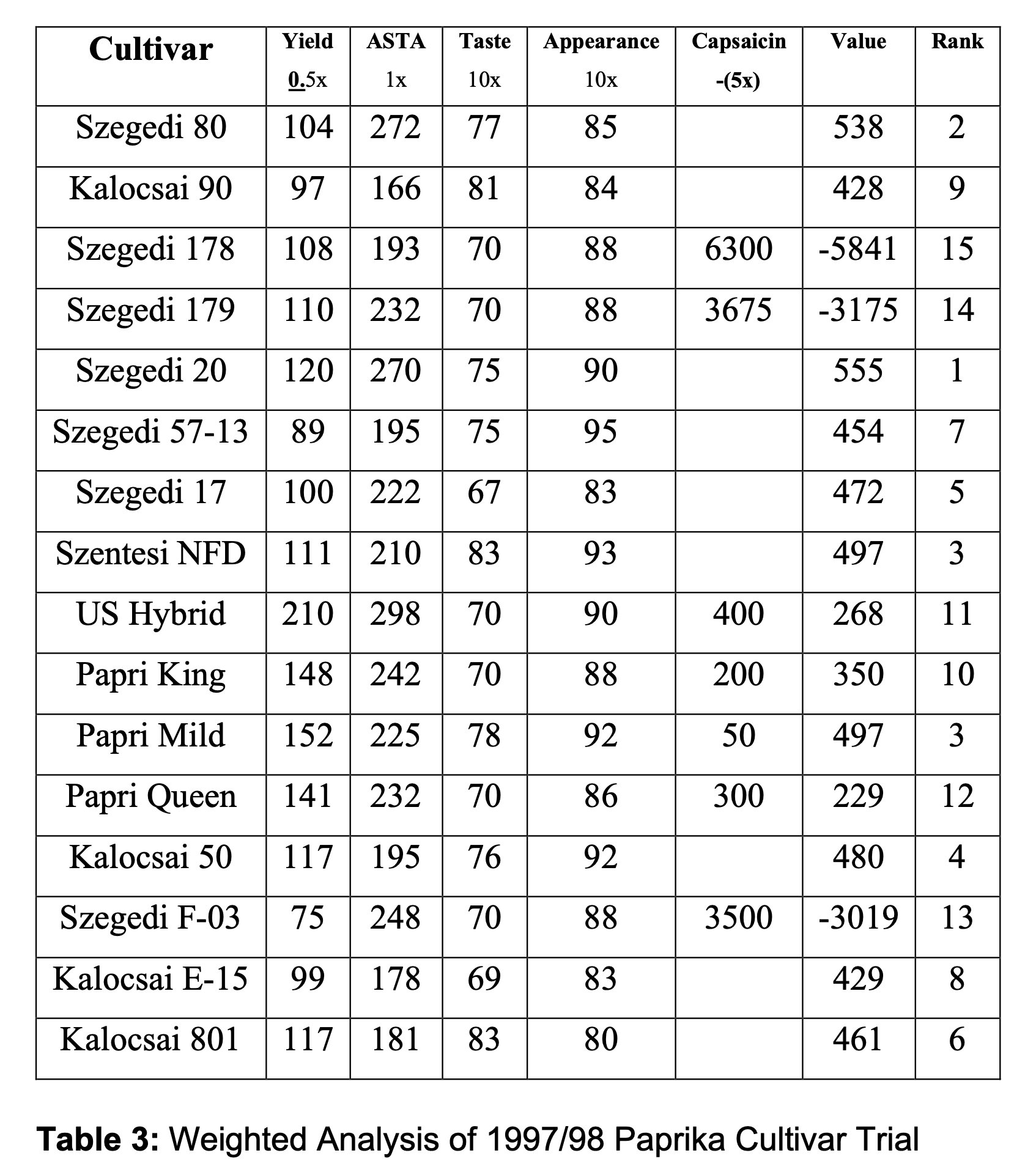
At Merriwa, we also had a sowing depth trial to determine the optimum depth of sowing on lighter soil where direct seeding could be justified. A 15 mm sowing depth was significantly better than 45 mm, and neither was significantly different from the 30 mm depth (Table 4).
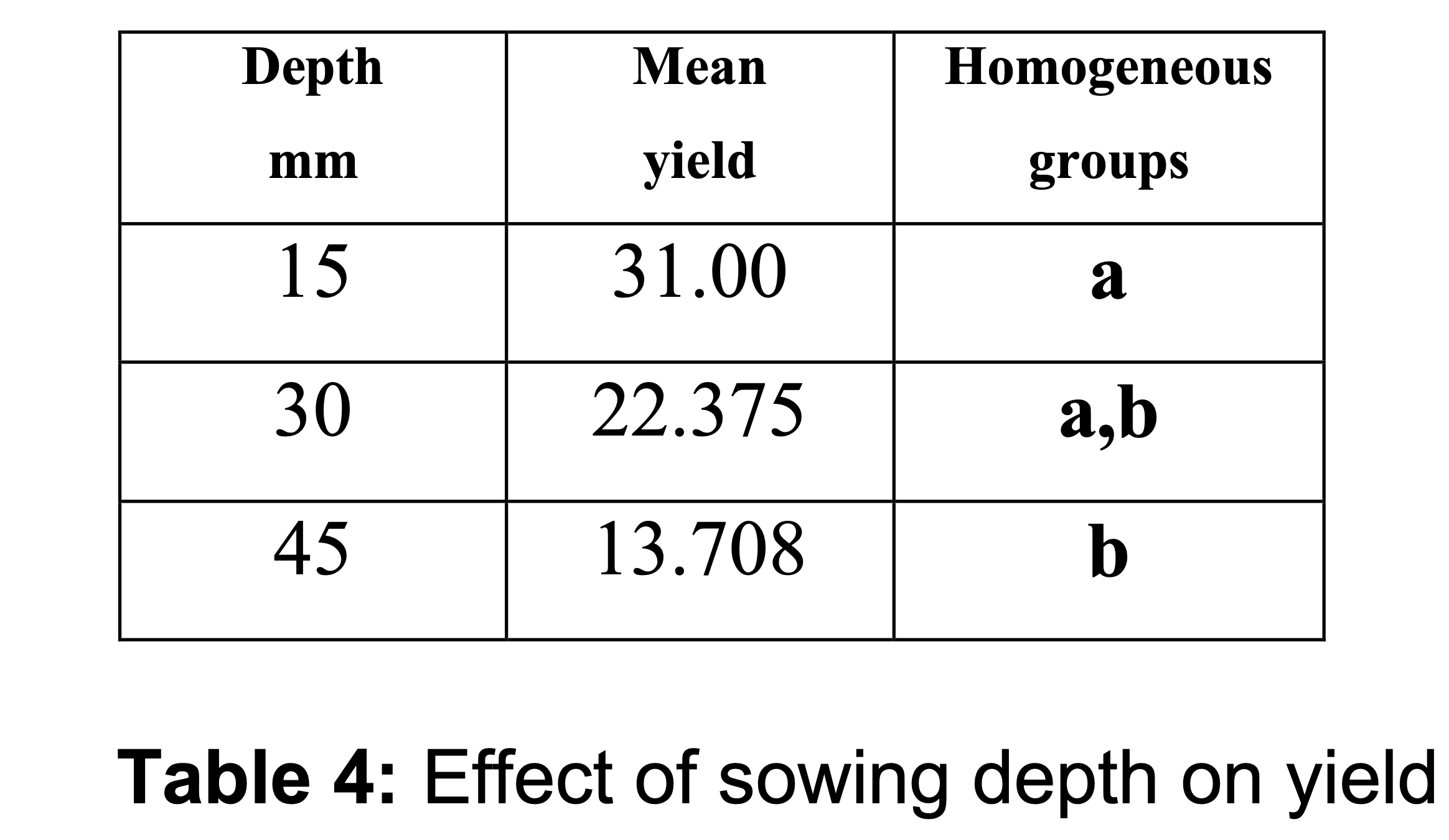
This result confirmed the Hungarian and the New Mexican recommendations on depth of sowing, and also emphasized the importance of soil types and moisture conditions. The extension workers of New Mexico strongly recommended covering the row with a 7-10 cm ‘cap’ which is removed with a dragging harrow before the seedlings emerge (crook stage) [9]. This method reduces the drying out of the seedbed. Post sowing watering can cause problems and should be avoided.
Four sowing times were combined with the depth of sowing in 15-day intervals starting on 1st October 1997. The results again supported overseas advice showing that the second sowing, mid-October, was the optimum sowing time. Obviously, the soil temperature must have been above the optimum level of around 15°C. At the third sowing time the seed emergence was significantly lower than at the second, but still acceptable. Both the first and fourth sowings gave significantly lower yields than the second and third sowings. They were not different from each other (Table 5).
The most favourable sowing time at Merriwa was in the second half of October in 1997 with a sowing depth between 15 mm and 30 mm depending on soil type.
Our practical experience and the experimental data indicated that the Hungarian and New Mexican crop husbandry practices could be adopted in Australia. However, plant improvement had to be given wide-ranging attention.
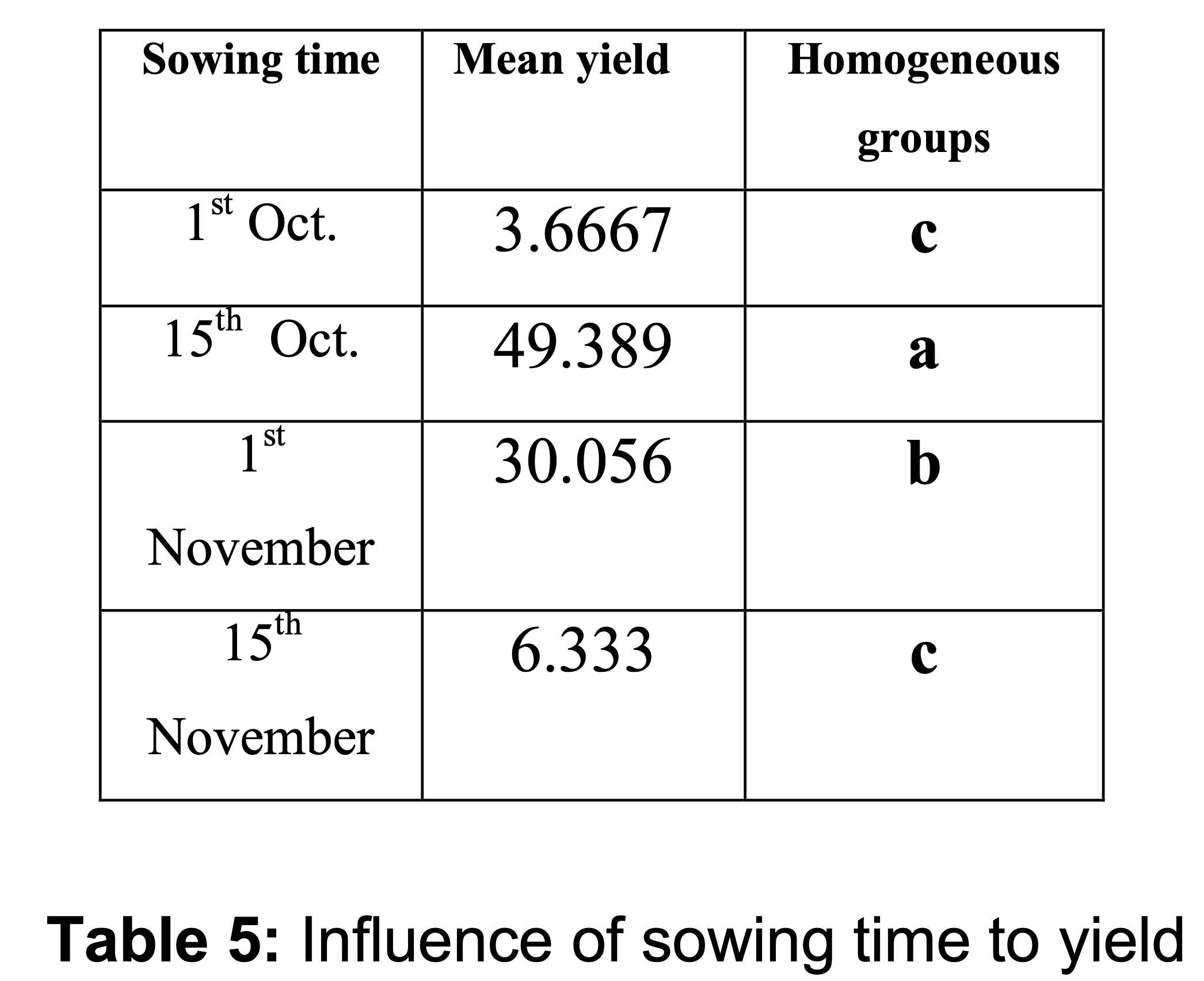
III. Genetic improvement of paprika
In order to develop paprika cultivars suitable for Australian climatic conditions and utilising a highly mechanised production system, we had to consider among other factors, high germination energy, a strong upright stem, fruit setting well above the ground, synchronised flowering together with a semi-determinate growth habit, snap-off pedicel with detachable calyx, fruits with high dry matter (18% +), very high pigment content (ASTA 200+), high yield and disease resistance. The paprika cultivar development was based mainly on the classical pedigree method, and to save time and space, it was combined with single seed descent (SSD; Fig. 1) [10]. The SSD method is widely applied in cereal breeding programs [11,12] and the senior author successfully used it earlier in wheat and ornamental Capsicum improvement work. With this system, two or three generations could be advanced in one year. We are using negative and positive selections while using the SSD method as it is shown in Figure 2.
In overseas condiment paprika breeding programs, the mechanisation requirements were neglected; therefore we had to build completely new plant types. The foundation was available in reasonably high quality Hungarian cultivars; nevertheless, they were not suitable for a mechanised production system and their pigment contents could be further improved. The foundation material consisted of introduced cultivars and ecotypes from Hungary and Spain, cultivars and wild species from the USA and South America, and materials from the germ plasm collection of the defunct Queensland capsicum breeding program.
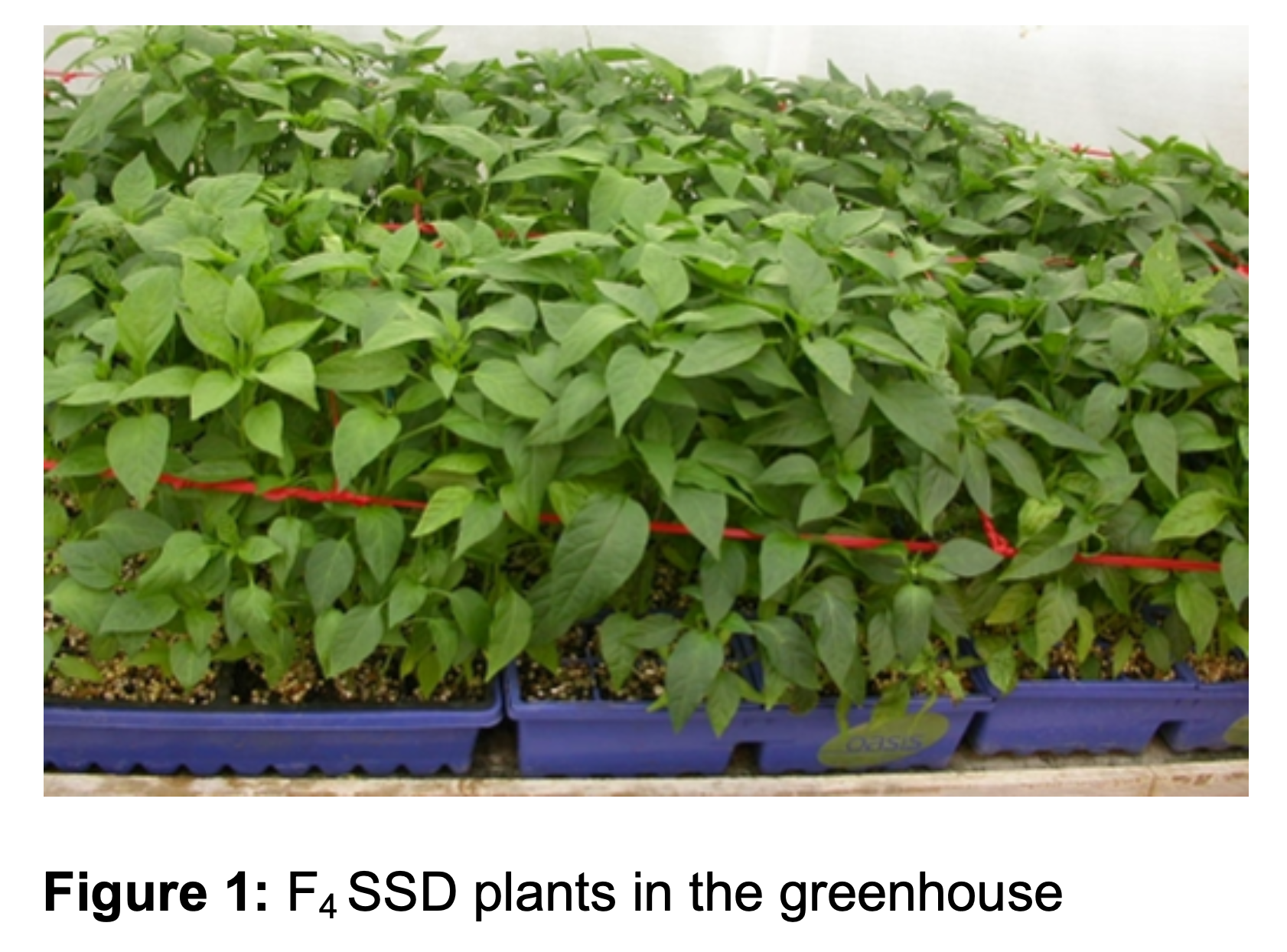
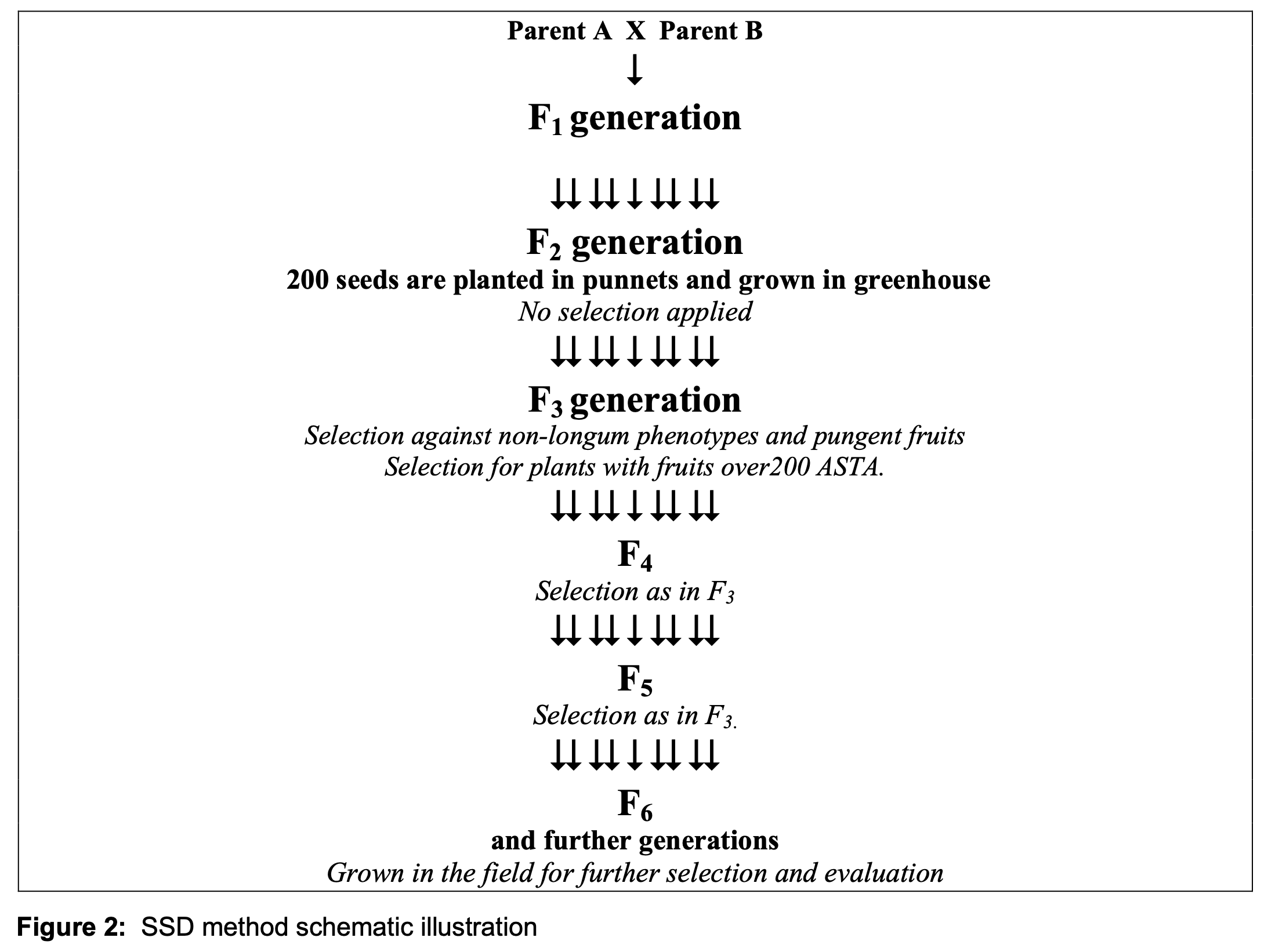
The collection was tested to find the appropriate traits to help build the new type of paprika. Most of the traits that we needed were represented in the collection, not in one given genotype but dispersed over several varieties and wild species. Therefore, we had to establish an ongoing crossing program to combine the appropriate genes into an acceptable breeding population. A number of interspecific crosses were required as well. Although most of the interspecific combinations were impossible to achieve according to the literature, we found a way to establish such combinations. Some of them needed several years to accomplish (e.g. detachability came from a wild species).
Some American cultivars displayed high yield potential and satisfactory pigment content. However, as they had variable levels of capsaicin content, low dry matter and inferior taste they were not suitable for the production of the Hungarian type of paprika. They were used as parents in the crossing program to improve the performance of the Hungarian paprikas. Special breeding lines were also created to increase the numbers of fruits produced per plant.
The interspecific combinations being used involved Capsicum chacoense, C. chinense, C. baccatum and various other C. annuum cultivars to achieve lignifications of the stem, and fruit detachability from the calyx (Fig. 3).
The program concentrated on backcrossing to maintain the Hungarian paprika’s quality traits with an improved yield but with easy detachability of the fruit from the calyx. According to the literature easy detachability of the calyx is associated with excess softening of the fruit at maturity [13]. The program used intermating of interspecific hybrids to find recombinants that were easily detached from the calyx (Fig. 3) while the ripe fruit remained firm. The earlier indication that these two characteristics are determined by common genes is incorrect; they are closely linked [14] and with appropriate selection can be separated. Capsicum chacoense crosses, to achieve detachability, were successful, but the F1 plants were sterile males and to obtain seed from them, they had to be pollinated with a fertile male cultivar. The unrestrained detachment of the fruit from the calyx was found to be a simply inherited incompletely dominant characteristic as it was reported [15].
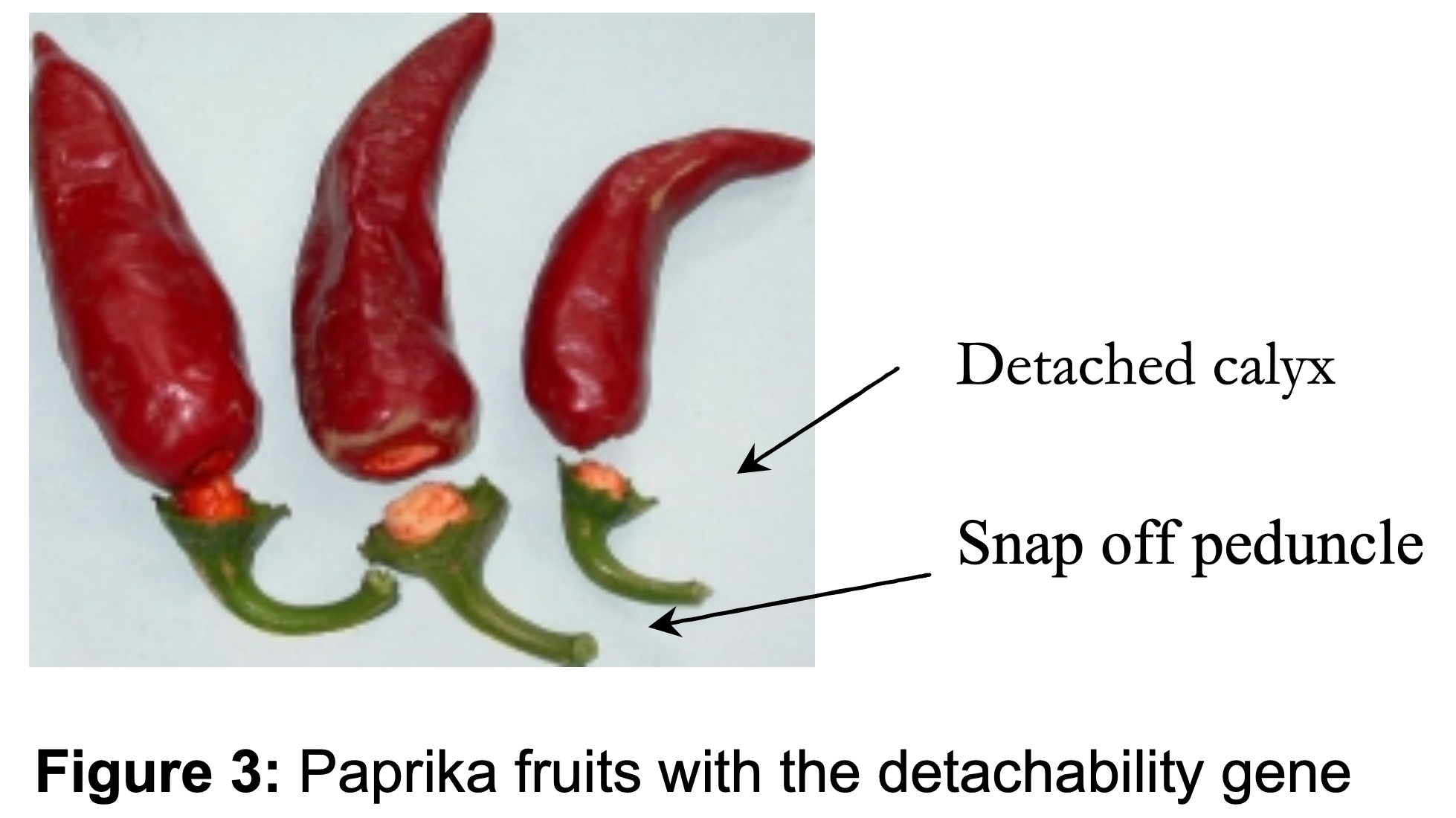
IV. The current selection program
Selection is conducted partly in the field and partly in the laboratory; in the field for phenotypic characteristics, and in the laboratory for dry matter and pigment content. Selection is repeated until the progenies show uniformity, usually in the seventh to tenth generations after the last cross. When some of the advanced lines are sufficiently uniform they are subjected to a rigorous program of at least three years of field testing, starting with three row plots and finishing with twelve row plots. When the performance of a line is acceptable, it is submitted for variety protection (PBR). This is followed by large-scale regional field tests on commercial properties and industrial tests before commercial release.
V. Outcomes
During 2004 we submitted three selections for plant variety protection (PBR), namely “Sunired”, “Earlysuni” and “Cerise Sweet”. The first two cultivars are reselections from introduced cultivars, which showed variability where first grown in Australia. “Cerise Sweet” originated from old Hungarian breeding material of the senior author; “Sunired” produced 89% of its total yield in the first harvest, and is therefore a good candidate for mechanical harvesting; “Earlisuni” is fast maturing with good dry matter and pigment content; “Cerise Sweet” (Fig. 4) is a constantly high dry matter and pigment (over 280 ASTA) producer. In our experiments, “Cerise Sweet” gave the highest pigment production per unit area. Due to the selection process all three cultivars have the ‘snap off’ gene that allows an easy separation of the pedicel from the stem.
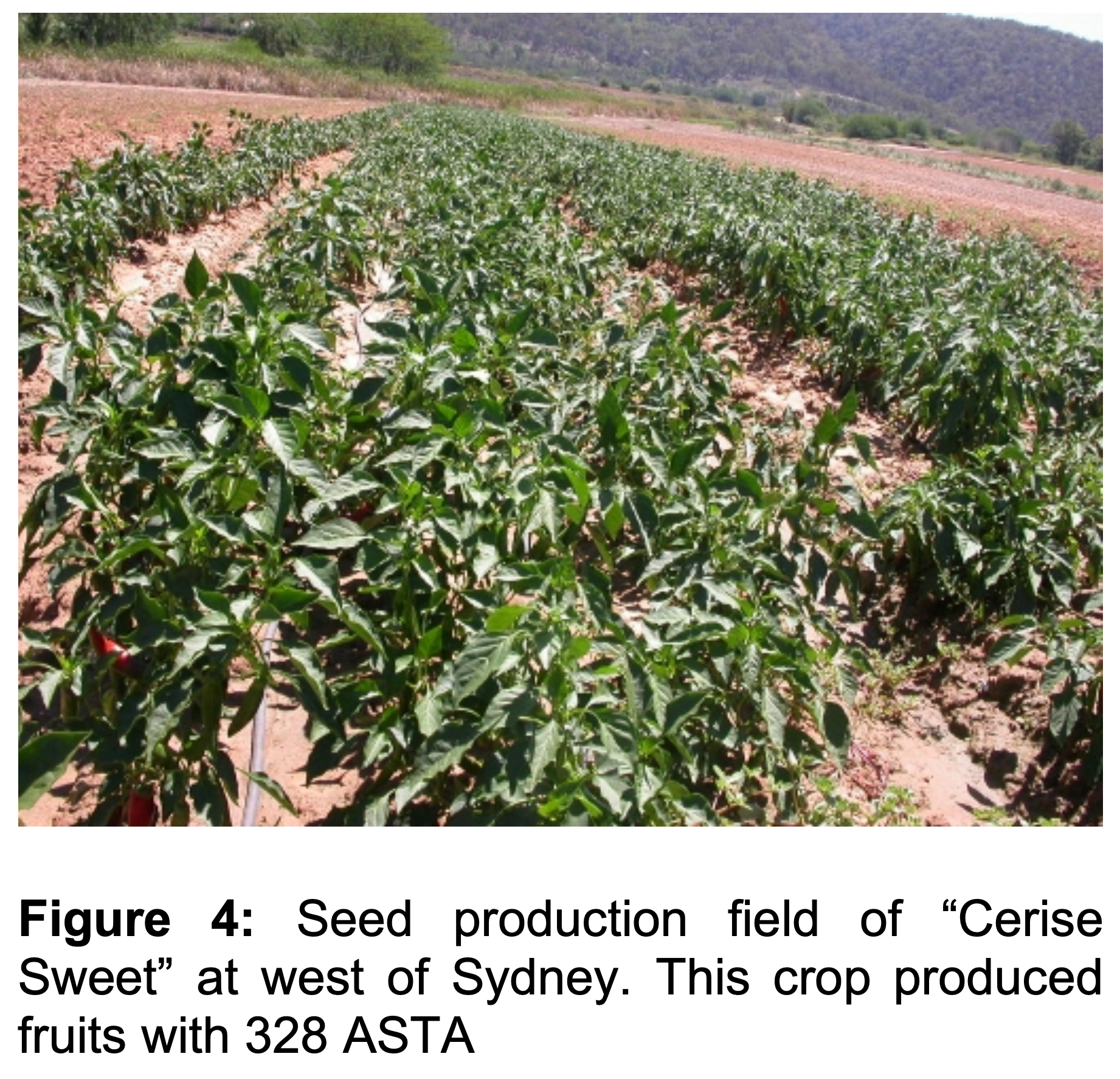
Fifty of our advanced lines are entering in our first year Variety and Strain trials. Their mean ASTA value is 310, all have the ‘snap off” gene
and 41 lines have the “detachability” trait, which allows the calyx to be removed from the fruit and simultaneously have the early lignification of the stem.
F6-F7 lines have an average 274 ASTA while the F5 selections mean ASTA is 266. Our segregating populations progress with limited selection by way of SSD to F5 (Fig. 2). We predict that in the near future, we will have cultivars on the market that have high pigment and dry matter content together with suitability for highly mechanised production systems.
VI. Capsicum Hybrid Seed
Research underway is attempting to produce condiment paprika hybrid seed in an economically acceptable price bracket. Currently hybrid paprika seed is sold by seed number, not by weight. As a consequence one kilogram of paprika hybrid seed can cost up to US$25,000 [16, 17, 18].
Capsicum is a facultative open-pollinated crop in Australia due to the activity of native bees, but is a facultative self-pollinated crop in Europe. Honeybees are not attracted to Capsicum because the nectar content in the flowers is low [19]. As a consequence, in Europe, 300 metres [20] is the compulsory separation distance for two cultivars of seed production; in contrast in Australia we may need 2-3 km or even greater distances due to the activity of the native bees.
It is important to reduce the cost of hybrid seed. We thus seek to use a designed system of sterile male paprika lines where the identification of sterile male plants is easy, and can be determined in the seedling stage. The selected sterile male plants can be propagated by micro-propagation or as cuttings. These male sterile plants would be planted in the field together with the pollen source and pollination would take place by native bees.
The improvement programs are based mainly on exploiting natural sources of germplasm by means of selection and hybridisation. Heterosis breeding has received considerable attention in crop production. The heterosis effect in capsicum manifests itself in higher early (yield at first harvest) and total yields, improved chemical composition, as well as other morphological features of the fruits [21, 22, 23, 24]. There is also significant heterosis for seed production in Capsicum hybrids made by using male sterile systems [25, 26].
In male sterile Capsicum plants versus fertile ones (Figure 5), the anthers are absent or shrunken, and contain either no pollen or only a small amount of viable pollen.
As in may other species; there are two different types of male sterility in Capsicum, genetic and cytoplasmic. Genetic male sterility is conferred by nuclear genes inhibiting the normal development of anthers and pollen, usually single recessive (ms) factors. Cytoplasmic male sterility is determined by mutant genes in cytoplasmic organelles, and is transferred only through the egg. The action of cytoplasmic genes for male sterility may be modified by the action of fertility restoring genes [27] in the nucleus: it is the interactive system that is exploited in hybrid production in many crops.
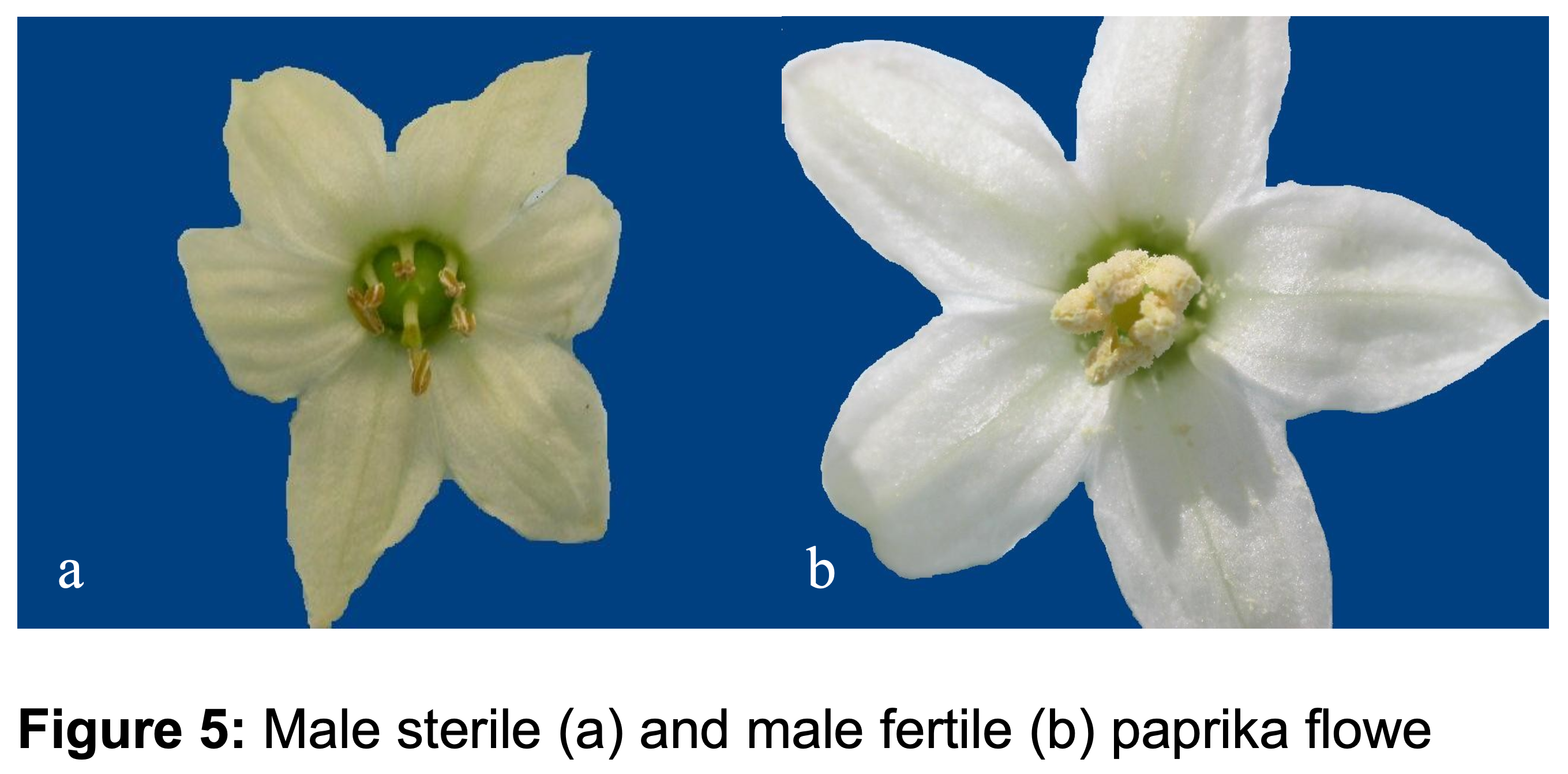
A wide range of methods have produced male sterility in Capsicum. The most widely used treatment for induction of male sterility is ionising radiation, such as gamma- or X-rays. There have been several investigations [28, 29, 30, 31, 32] to determine the optimal conditions for mutagenesis by chemical agents. Chemically induced male sterility mutants were incomplete in many cases, climate dependent, and invariably accompanied by unfavourable effects on the development of plants, and also caused high ovular sterility. Gametocides can induce a temporary male sterility in several crops, including Capsicum [33, 34]. The use of a gametocide requires uniform plants in the same developmental stage. Weather events can influence the timing of application and the effect of gametocides at the optimal treatment stage. There is also the added problem of gaining a licence for the use of gametocides.
Interspecific hybrids between species of Capsicum can be made with varying degrees of success [1]. The hybrids can be sterile in paprika due to chromosomal or plasmon-genome incompatibility [35]. There are several known male sterile lines used in research programs. These differ from each other in agronomic characters, growing time, combining ability, plant growth habit and fruit type. They carry various male sterility genes [36].
To generate male sterility in condiment paprika we collected known male sterile Capsicum lines from around the world. This collection consisted of cytoplasmic and genetic sterile male lines (Table 6). We backcrossed these lines into condiment paprika and during the selection program we established sterile male lines of paprika.
Gamma irradiation of seeds was also used to generate male sterility in the Longum group type of Capsicums. Seeds were soaked in distilled water for 0, 48 and 96 hours prior to irradiation at 3, 5, 7, 9, 12, and 15 Krads. Seeds, soaked for 0, 48 and 96 hours, not exposed to radiation were used as controls. Controls did not produce male sterile plants. The overall frequency of male sterility among the irradiated materials was 0.3% (Table 7). The percentage of sterile male plants increased with increasing radiation dose. Induction of male sterility was more successful with increasing soaking periods. The mutants were incorporated into our breeding program.
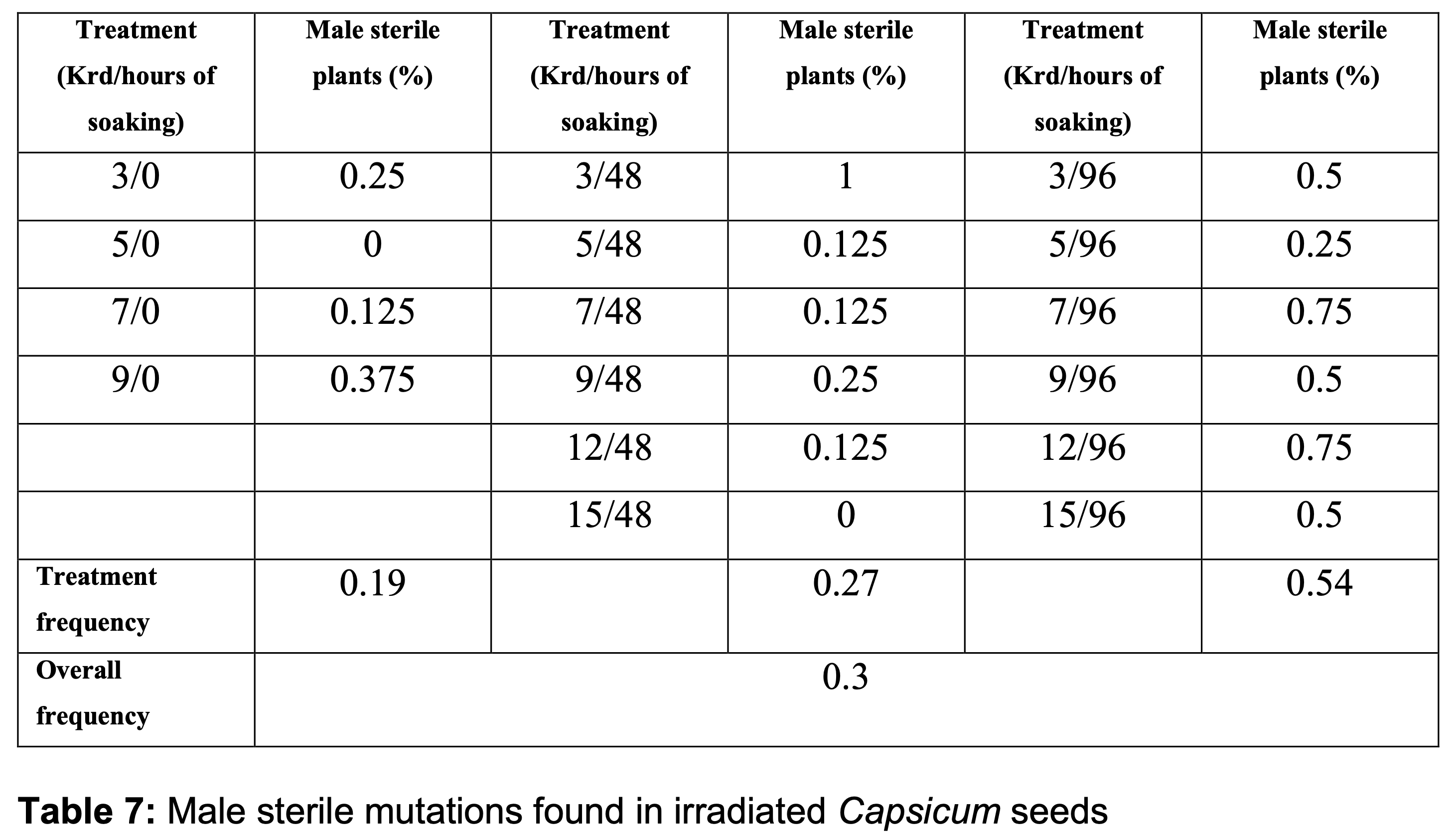
Plant material was grown in flying insect proof isolation tunnel houses. Certain phenotypic/physiological characteristics, e.g. shrunken anthers of male sterile flowers, plant height and flowering time were found to be markers for male sterility though male sterility can only be detected at the flowering phase. Our aim is to select sterile male plants at the seedling stage, so that only sterile male plants would be planted into the field along with the pollen source. The production field would show a uniform pattern (number of male sterile rows alternating with a certain number of rows of pollen source) ensuring the efficient usage of available land and other resources.
In order to identify a genotype with a unique trait that cannot be observed at a particular growth stage, ‘markers’ can be used. These can be phenotypic or molecular. Since no phenotypic markers for male sterility were apparent at seedling stage we decided to use the Amplified Fragment Length Polymorphism® (AFLP) method to find molecular markers linked to the ms3 male sterility gene, which is widely used in our and other research/breeding programs. We have one candidate primer combination [37], which potentially allows us to select for male sterility at the seedling stage (Fig. 6). The validation of this possible marker is underway.
Sterile male plants can be propagated with the help of micro-propagation [38, 39] or as cuttings [40]. Different explant types can be used to propagate sterilemalelinesinvitro.Severalmediahavebeen tested, and that with the highest multiplication rate will be used for propagation. Cutting-derived young plants are produced in the greenhouse (Table 8) and then tested under field conditions to compare to seed derived seedlings.
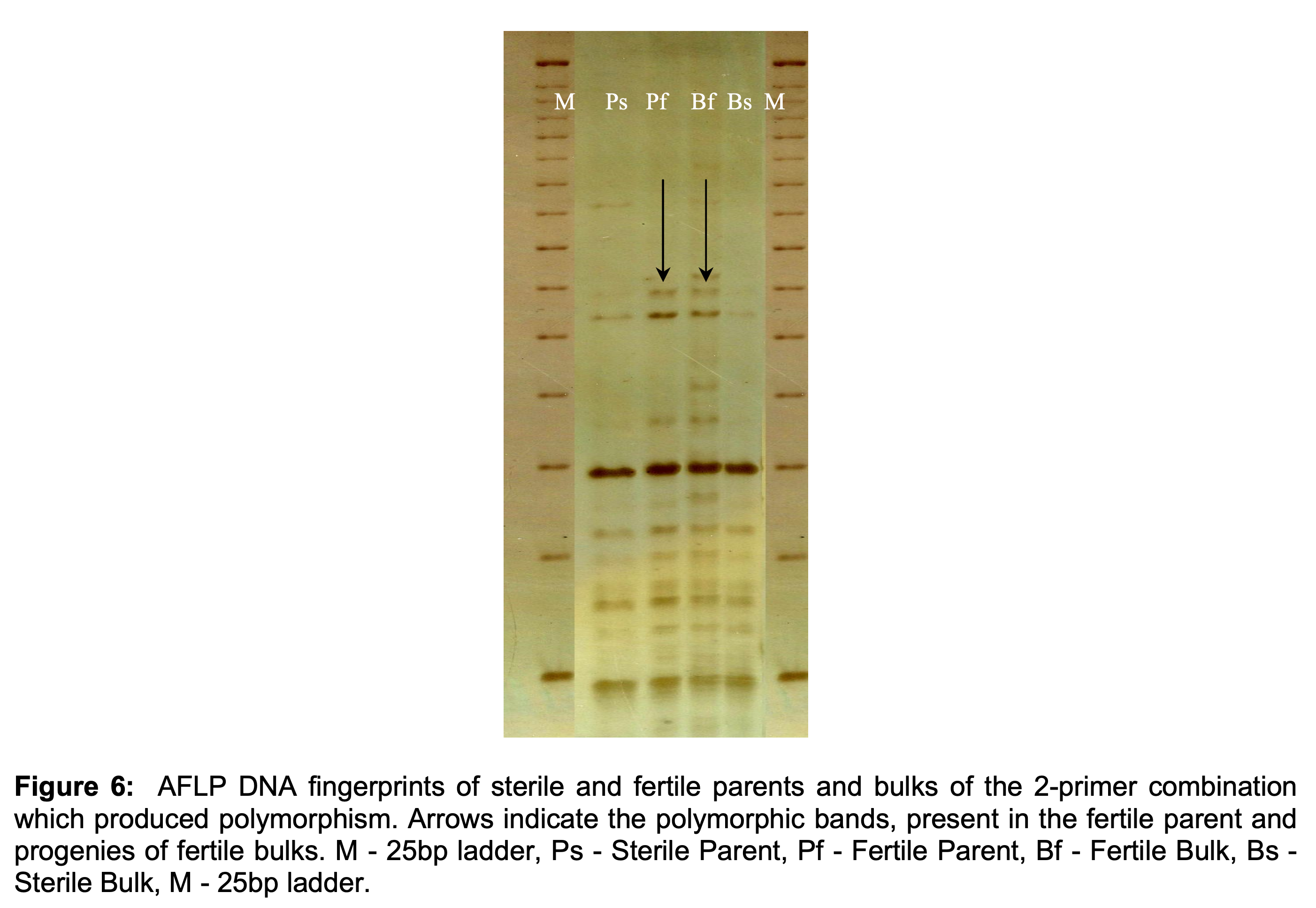
It is planned that male sterile plants will be planted with a pollen source, with pollination taking place by insects, mainly native bees (genera Trigona, Austroplebeia, Xylocopa, and Amegilla) [41]. These sting-less native bees are found across Australia and are known to be good crop pollinators even for Solanaceae, where ‘buzz’ pollination is required [42].
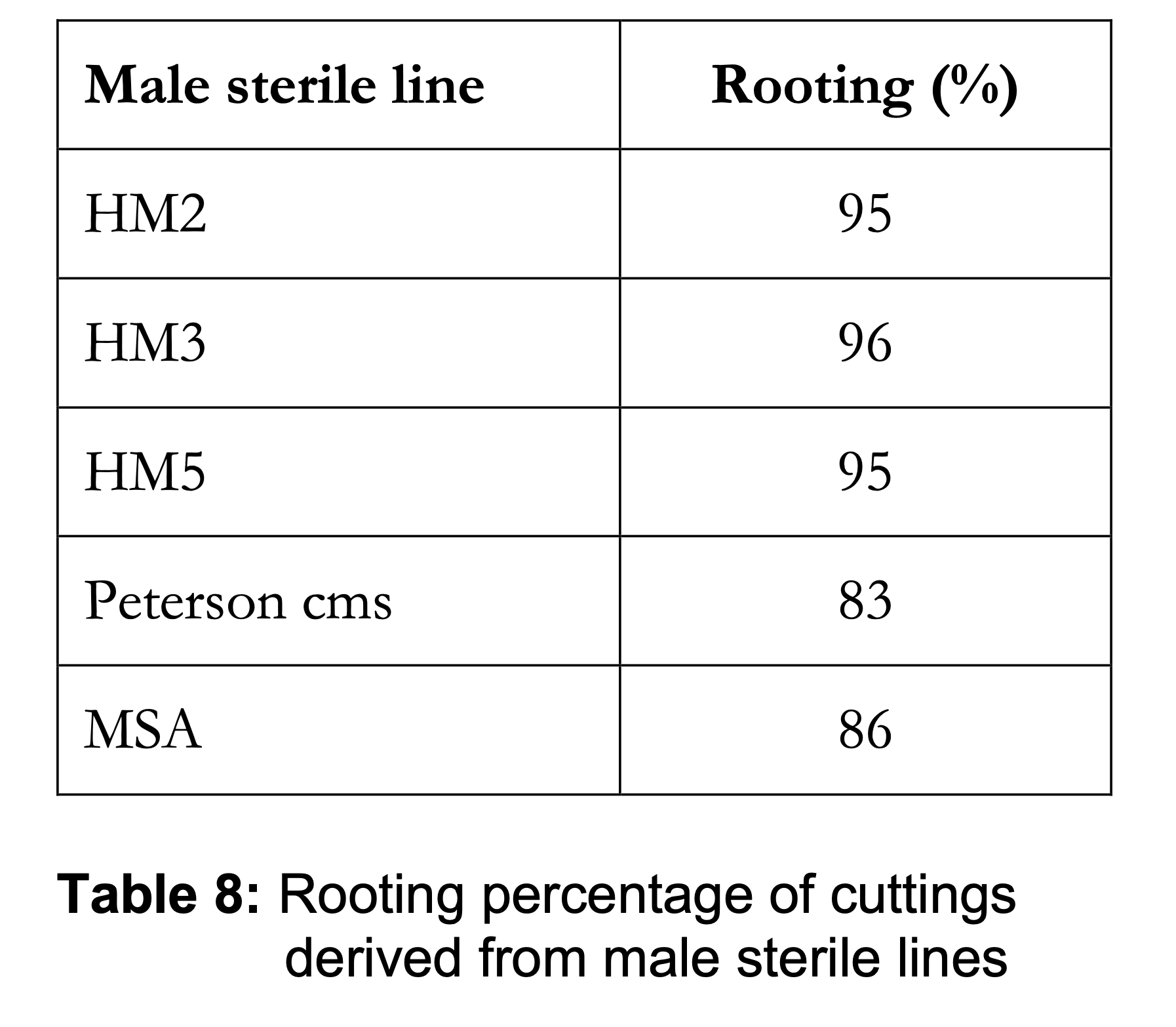
During field trials a cost benefit study will be carried out to determine the economics of hybrid paprika seed production in Australia using this system. This will enable us to determine the most efficient method of large-scale hybrid paprika seed production within a reasonable price bracket.
VII. Conclusion
We believe that by applying this system we should be able to produce paprika hybrid seed in an economically acceptable price bracket. If so, the “product” would be marketable worldwide because of the increasing demand for paprika as a spice and natural colouring agent. This could open up a new avenue for the Australian industry as an exporter of paprika products and hybrid seed of our improved cultivars that are both fit for highly mechanised production and have a high pigment and dry matter content.
Acknowledgements
The authors wish to express their gratitude to the Australian Government Rural Industries Research and Development Corporation (RIRDC) for financial support and encouragement during the past seven years. N. Nagy is grateful for a scholarship sponsored by RIRDC. Thanks are due to The University of Sydney Plant Breeding Institute for providing facilities, to Professors R.A. McIntosh and P.J. Sharp for their constructive comments during the preparation of this manuscript. Previous technical assistance of Fran Ebb and Sue Fiffer must be acknowledged. The cooperation of the Hunter Valley Herb Farm at the initiation of this project is gratefully acknowledged.
References
[8] Balaam, L.N. (1972) The Randomized Complete Block Design Fundamentals of Biometry. The Science of Biology Series No. 3, George Allen & Unwin Ltd.
[20] Hungarian Seed Act MSZ 7145/1999; CXXXI 1996/3/19
[30] Bhargava, Y.R., Umalkar, G.V. (1989) Productive mutations induced in Capsicum annuum by physical and chemical mutagens. Acta Hort. 253, pp 233-238
[42] Raw, A. (2000) Foraging behaviour of wild bees at hot pepper flowers (Capsicum annuum) and its possible influence on cross pollination, Ann. Bot. 85, pp 487-492